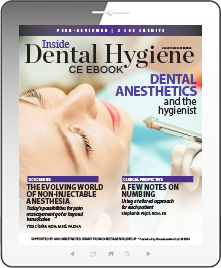CDEWorld > eBooks > Dental Anesthetics and the Hygienist


ADA CERP is a service of the American Dental Association to assist dental professionals in identifying quality providers of continuing dental education. ADA CERP does not approve or endorse individual courses or instructors, nor does it imply acceptance of credit house by boards of dentistry. Concerns or complaints about a CE provider may be directed to the provider or to ADA CERP at www.ada.org/cerp/

Approved PACE Program Provider. FAGD/MAGD credit. Approval does not imply acceptance by a state or provincial board of dentistry, or AGD endorsement. 1/1/2023 to 12/31/2028. ID # 209722.
eBook
Released: Tuesday, August 27, 2024
Expires: Saturday, October 31, 2026
Dental Anesthetics and the Hygienist
Commercial Supporter: DirectaDentalGroup
Making patients comfortable during treatment is of utmost concern for dental hygienists. Options for pain management include both topical and injectable anesthesia. This Inside Dental Hygiene eBook covers the key fundamentals of pain management. A CE article reviews various non-injectable options. An additional article explores how using a tailored approach for each patient is often the most desirable approach. Download to earn 2 FREE CEU now!
FEATURED CONTENT
CE: The Evolving World of Non-Injectable Anesthesia
Tina Clarke, RDH, MEd, FADHA
Needle-free anesthesia continues to be the first choice of patients for multiple dental procedures, with many different delivery techniques and modalities available. This article covers the various non-injectable pharmacological options, including benzocaine; lidocaine; a combination of lidocaine and prilocaine; a combination of benzocaine, tetracaine, and butamben; and dyclonine hydrochloride. A non-pharmacological option for pain management involving transcutaneous electrical nerve stimulation (TENS) is also described.
Credits: 2 Self-Study CEU
Cost: $0
Provider: Conexiant Education
A Few Notes on Numbing
Stephanie A. Pajot, RDH, BS
Topical and injectable anesthetics of varying kinds are essential components of the dental armamentarium. When the patient is comfortable, the hygienist is better able to provide superior treatment. This article describes why a using a tailored approach for each patient is beneficial.


